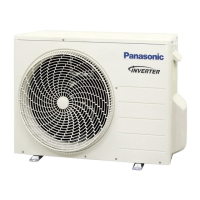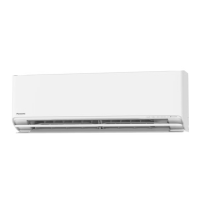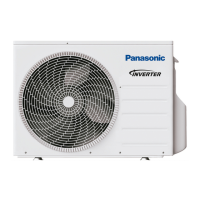Why my Panasonic CU-2Z41TBE makes cracking sound?
- DdanaconnerAug 30, 2025
A cracking sound during operation of your Panasonic Air Conditioner is due to temperature changes causing the expansion or contraction of the unit.
Why my Panasonic CU-2Z41TBE makes cracking sound?
A cracking sound during operation of your Panasonic Air Conditioner is due to temperature changes causing the expansion or contraction of the unit.
Why is my Panasonic CU-2Z41TBE Air Conditioner noisy?
If your Panasonic Air Conditioner is noisy during operation, check whether the unit has been installed at an incline. Also, make sure that the front panel is closed properly.
How to improve HEAT/COOL efficiency in Panasonic Air Conditioner?
If your Panasonic Air Conditioner isn't operating efficiently in HEAT/COOL mode, ensure that you set the temperature correctly, close all doors and windows, clean or replace the filters, and clear any obstructions at the air inlet and outlet vents.
Why does my Panasonic Air Conditioner outdoor unit emit water or steam?
The outdoor unit emits water or steam because condensation or evaporation occurs on the pipes.
Why is the TIMER indicator always on in my Panasonic Air Conditioner?
The TIMER indicator is always on because the timer setting repeats daily once set.
How to improve HEAT/COOL mode efficiency in Panasonic CU-2Z41TBE?
If your Panasonic Air Conditioner isn't working efficiently in HEAT/COOL mode, ensure the temperature is set correctly, all doors and windows are closed, the filters are clean or replaced, and there are no obstructions at the air inlet and outlet vents.
What to do if my Panasonic CU-2Z41TBE Air Conditioner doesn't receive the remote control signal?
If the Panasonic Air Conditioner unit does not receive the signal from the remote control, ensure that the receiver is not obstructed. Note that certain fluorescent lights may interfere with the signal transmitter; consult an authorised dealer.
Why does dust accumulate on the wall near my Panasonic CU-2Z41TBE Air Conditioner?
Dust accumulation on the wall near your Panasonic Air Conditioner may be due to air circulation or static electricity generated by the air conditioner.
What to do if Panasonic Air Conditioner remote control does not work?
If the remote control for your Panasonic Air Conditioner isn't working, first ensure that the batteries are inserted correctly. If the display is dim or the transmission signal is weak, try replacing the batteries.
What to do if Panasonic Air Conditioner doesn't receive signal from remote control?
If your Panasonic Air Conditioner isn't receiving the signal from the remote control: * Ensure that the receiver is not obstructed. * Be aware that certain fluorescent lights may interfere with the signal transmitter.
Read instructions thoroughly for future reference. Keep Installation Instructions for installer.
WARNING for death/serious injury, CAUTION for injury/property damage. Understand safety symbols.
Appliance use by children requires supervision. Do not install in flammable atmosphere.
Use correct cords, do not share outlets, avoid wet hands, do not bend cord. Ground equipment.
Appliance uses R32 (flammable refrigerant). Risk of fire if leaked near ignition source.
Install in minimum room area. Keep away from ignition sources. Ensure ventilation is clear.
Higher pressure than R22/R410A. Replace piping/flare nuts. Do not mix refrigerants.
Locate circuit/piping away from heat sources. Regularly check alarms and ventilation.
Requires knowledge of flammable refrigerants, handling skills, and relevant legislation.
Protect pipe-work from damage. Comply with gas regulations. Ensure accessible connections.
System inspected by trained personnel. Ensure refrigerant charge and no leaks. Work with controlled procedures.
Minimize flammable gas risk. Avoid confined spaces. Wear protective equipment. Keep ignition sources away.
Check area with detector. Use suitable equipment. Ventilate if leakage occurs.
No ignition sources during work. Do not smoke. Survey area for hazards before work.
Check electrical components, refrigerant charge, ventilation. Ensure markings are legible.
Disconnect power for repairs. Use leak detection. Check cabling for wear and environmental effects.
Use appropriate leak detection methods. Avoid naked flames for detection.
Recover refrigerant, purge with inert gas, evacuate. Use OFN for purging.
Prevent contamination, use short hoses, earth system, label system. Avoid overfilling.
Familiarize with equipment, isolate electrically, ensure handling equipment, PPE, supervision.
Recover refrigerant safely using appropriate cylinders. Ensure correct number of cylinders.
Use remote to retrieve error codes. Write down code and consult dealer.
Table of diagnostic codes (Hxx, Fxx) and their corresponding abnormalities/protections.
| Cooling Capacity | 4.1 kW |
|---|---|
| Power Supply | 220-240 V, 50 Hz |
| Refrigerant | R32 |
| Operating Range Cooling | -10°C to 46°C |
| Operating Range Heating | -15°C to 24°C |












